Although a tendency of infant accident is constant for long years, nobody can develope effective measures.
Because tools for clarifying infant behaviors and the cause of infant accident don't exist.
For solving the problem, development of the tool for simulating infant accident
by recreating infant behavior on a computer is important. We thougt that infant behaviors
depend on situation of environment and developmental stage strongly,
we are developing infant behavior simulator based on these data.
We look forward to infant behavior simulator being applied on
evaluation of safety at home or clarification of cause of accident
by integrating the simulator and accident database that we will create.

We classify the determinant factors of infant behavior into internal factors and external factors.
Internal factors are factors related to an infant that infant developmental behavior, physiology and so on.
External factors are factors an environment surrounding an infant.
We modeled developmental behavior and function of environmental interest and behavior induction
because these factors relate infant behaviors strongly.
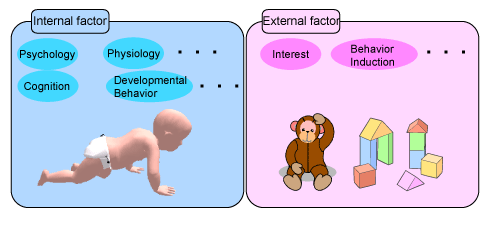
Developmental Behavior Model
Developmental Behavior Model is modeling relation of age and possible behaviors (ex. A infant can walk when he/she is one year old.) and
transition of behaviors (ex. sit -> stand is possible, sit -> run is impossible).
We modeled using "Denver II". "Denver II" is a check sheet that pediatricians use for checking infant developmental stage.
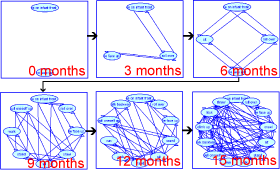
Environmental Model
- Function for inducing infant interest
We measure infant behavior and analyze the data in parallel with development of infant behavior simulator.
We got a knowledge that relation of distance and infant interest from the data.
We modeled this function using this knowledge.
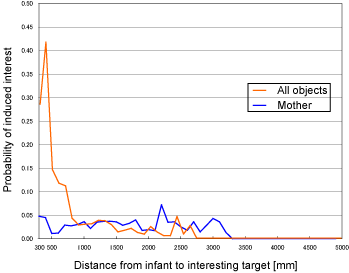
- Function for inducing infant behavior
We modeled this function using behaviors we got behaviors from behavior measurement and instance of accident.
We can get lists of a behavior and probability using following method.
For example, grab a ball 0.2, pull himself up using a table 0.6, climb up a chair 0.4.
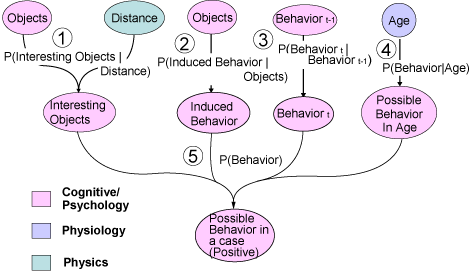
|
1. Computation of probability that interest to a object
2. Computation of probability that induced behaviors by a object
3. Computation of probability that next behaviors based on state transition
4. Computation of probability that next behaviors based on developmental stage
5. Computation of probability that next behaviors
|
We verified the simulator comparing result of simulation and the data of behavior measurement.
We calculated following items for comparing.
Inclusion rate: Rate of behavior nomination which simulator outputs inclues a behavior which acctual behavior takes.
Contribution ratio: Ratio of impact of change of threshold on inclusion rate. Threshold is set to probability of behavior.
Result
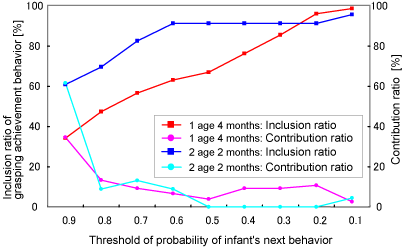
In the graph, horizontal axis indicates threshold which is set to probability of a infant next behavior.
Left vertical axis indicates inclusion rate, right one indicates contribution ratio.
Inclusion rate becomes higher as threshold becomes lower.
Because lowering threshold means behavior nomination includes behaviors of low probability,
i.e. behaviors that simulator predicts infant doesn't take them often.
Contribution ration becomes lower as threshold becomes lower.
It means that behaviors that simulator predicts infant take them often have a big impact on inclusion rate,
behaviors that simulator predicts infant doesn't take them often have a small impact on inclusion rate.
That is to say, actual infant takes behaviors that simulator predicts high probability with high probability,
conversely, actual infant takes behaviors that simulator predicts low probability with low probability.






